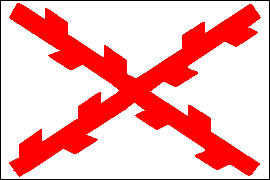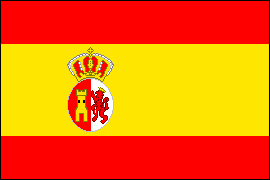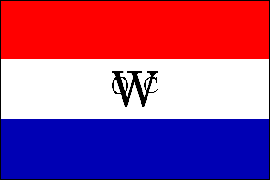|
THE ENGLISH SETTLEMENT |
|

Cross of St. George |

First Union Jack •
1606-1801 |
|

East India
Company Ensign • Early 17th Century |
|

English Red
Ensign • Later 17th Century-1707 |

British Red
Ensign • 1707-1801 |
|

New England Ensign • 17th
Century |

New England Ensign • 18th
Century |
|
The early explorers and
settlers of what would become British North America sailed under the Cross of
St. George and the ensigns derived from that ancient symbol of England. The
Union Jack, combining
the crosses of SS. George and Andrew, was created by
a royal writ issued in 1606 by King James I.
Initially it was intended for the use of English and Scottish merchant vessels,
being flown together with the Cross of St. George by the former and the Cross of
St. Andrew by the latter. In 1610,
when the English explorer Henry Hudson sailed into the immense bay that was to
be named after him, his ship, the Discovery,
may have flown the Union Jack together with an early version of the ensign of the
East India
Company, which financed his final (and fatal) expedition in
search of a Northwest Passage. Similar striped ensigns, in
common use in the early seventeenth century, gave way to ensigns with a
solid-color field around 1630. By this time the Union Jack was reserved for the
Royal Navy and, legally,
English merchant vessels should have flown the Cross of St. George only. Many,
however, flew the Red Ensign also and in 1674 a royal proclamation legalized
this practice. In 1707 the Act of Union between England and Scotland created the
United Kingdom of Great Britain and the Union Jack replaced the Cross of St.
George in the canton of all ensigns. The two versions of the Red Ensign were a
familiar sight in North American waters between the mid-seventeenth century and
1775. With a green pine tree added in the upper hoist they served as merchant
ensigns of colonial New England, though without official sanction.
|
|

Flag of the Massachusetts Bay Colony
• 1636-86 |

Governor Andros Flag • 1687-89 |
|
Claiming
that the Cross of St. George was idolatrous and papist, Governor John Endicott
of the Massachusetts Bay Colony demanded to have it removed from the militia
colors of the town of Salem. The Great and General Court (legislature) of the
colony, finding that Endicott had "exceeded the lymits of his calling,"
vacated his order and banned him from holding public office for one year. The
decision on the cross was left up to local officials, many of whom, particularly in the
Boston area, shared Endicott’s opinion and suppressed the cross. The English Red
Ensign was similarly modified and for fifty years the ensign, albeit
unsanctioned by the English government, of the colony was red with a blank white
canton. Religious sentiment against it have largely died down with the
passage of time, the cross was restored in 1685-86.
Seeking
to consolidate royal authority in North America as well as in England, King
James II proclaimed a united Dominion of New England in 1686. As governor he
appointed Sir Edmund Andros, who arrived in Boston the following year to take up
his office. The Dominion, consisting of the New England colonies plus New York,
was exceedingly unpopular with the colonists, who by this time were well used to
self-government. When the Glorious Revolution broke out in England in 1688 the
colonists rose against Andros, he was deposed along with the King and the
Dominion was dissolved. The so-called Governor Andros flag was probably the
company color of the military guard that accompanied him to Boston; it was
similar to the company colors of the
English foot guards. |
|

Colonial Union
Jack • 1701-? |
|
The Colonial Union Jack, defaced with a pain
white
escutcheon,
was created in 1701 after complaints from the Admiralty that
merchant vessels registered in the colonies were illegally flying
the Union Jack. It was probably not much used, being largely
superseded by the British Red Ensign after 1707. |
|
THE
FRENCH SETTLEMENT |
|

The
Banner of France |
|

Variant Design |

Variant Design
• Semé of
Fleurs-de-Lis |
|
 |
|

|
 |
|
French Merchant
Ensigns • 17th-18th Centuries |
|
The French settlement of North
America was centered on Canada. A banner of the arms of France—three
gold
fleurs-de-lis
on a field of blue—was probably the
first French flag to fly over North America. Variants of this flag
with a white field—white being the livery color of the House of
Bourbon—are also known to have existed, either with the three
fleurs-de-lis
or
semé
of
fleurs-de-lis
in the manner of the ancient arms of France. Several versions of
this ensign are known to have existed. A common sight in North
American waters was the French merchant ensign, blue with a white
cross throughout and the arms of France at the intersection of the
cross. Though Canada was lost to Britain in 1763 French social and
cultural influence in what was to become the province of Quebec
remained strong, as it is to this day. |
|
THE SPANISH SETTLEMENT |
|

Kingdom of
Spain • State Ensign • 16th-18 Centuries
|

Kingdom of Spain • Merchant Ensign
16th-18 Centuries |
|
The Cross of Burgundy had been the symbol of the Dukes of Burgundy
since the early fifteenth century. Around 1525 it was adopted by
King Philip I of Castile, the first Spanish Habsburg monarch, whose
mother was Mary of Burgundy. With a white field and a red cross it
served as the Spanish state and war flag and ensign. For merchant
vessels there was a variant with a blue field and white cross. The
Cross of Burgundy was flown throughout Spain's vast possessions in
North and South America until being superseded by the
red-yellow-red flags of King Charles III in 1785. |
|

Kingdom of Spain •
State Ensign • 1785-1931 |

Kingdom of Spain
• Merchant Ensign
•
1785-1927 |
|
In 1785 King
Charles III adopted a new ensign for the Spanish Navy, striped
red-yellow-red with the crowned state arms on the yellow stripe. For
many years its use was restricted to state and naval vessels and
installations. A new merchant ensign in the same colors but of a
different design was adopted at the same time. These flags flew over
Spain's American colonies until the last of them were lost in 1898.
|
|
OTHER EUROPEAN
SETTLEMENTS |
|

Dutch Republic
• The Princevlag
• 16th-17th Centuries |

Dutch Republic
• Doubled
Princevlag |
|

Geoctroyeerde Westindische Compagnie |
|
The Dutch settlement of North
America, which began in 1614, came to center on Manhattan Island and
the Hudson River Valley. New Netherland, as the colony was known,
eventually established its capital, New Amsterdam, on the island of
Manhattan. Like various other European colonial settlements in the New
World, New Netherland was a private business venture, the
Geoctroyeerde Westindische Compagnie (Chartered West India
Company) being primarily interested in the American fur trade.
Though at first New Netherland grew slowly its settled area
eventually came to include portions of the current states of New
York, New Jersey, Delaware, and Connecticut plus small outposts in
Rhode Island and Pennsylvania. The Anglo-Dutch wars of the later
seventeenth century led to the loss of New
Netherland to England in 1674 and its name was changed to New York.
Dutch cultural, political and economic influence remained strong,
however, and persist to this day.
The orange-white-blue Princevlag was the de facto flag of
New Netherland. Often it was made with multiple stripes: the basic
flag doubled or even tripled. From about 1640 red began to
replace orange, probably because of the unreliability of the orange
dyestuffs of the period. The
Geoctroyeerde Westindische
Compagnie used both the orange-stripe Princevlag and the
later red-stripe version with its monogram on the white stripe as
the ensign of its ships. |
|

Kingdom of Sweden •
State & War Ensign • 1520-1650 |
|
The colony of New Sweden was
established in the Delaware River valley at the instigation of Queen
Christina, who granted a charter to the
Svenska Västindiska
Kompaniet (Swedish West India Company) in 1637, the colony’s
purpose being to develop transatlantic trade. By 1650 there were
a number of settlements on either side of the Delaware River.
However in 1655 New Sweden was invaded and occupied by the Dutch,
who incorporated it into New Netherland. The Swedish state and war
flag, which up to 1650 had two rather than three tails, was the
colony’s flag and ensign.
|




















